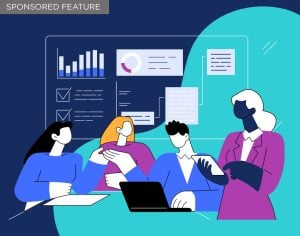As businesses become more and more focused on ideas and innovation, inevitably the kinds of assets they tend to hold have shifted away from machinery, fleets and property. “We are moving rapidly towards a knowledge-based economy,” says Adam Tavener, chairman of Clifton Asset Management, the pension-led funding provider. Instead intangible assets – such as branding, business processes, intellectual property (IP) like patents and copyrights, software and contents of databases – have come to dominate the balance sheet of most businesses. “Traditional British industry still exists to an extent but it is a smaller and smaller part of the overall pie,” he says.
Given the fact that fewer small- to medium-sized enterprises (SMEs) are tying their limited funds up in expensive overheads like property and a fleet of company vehicles, the most significant part of their balance sheet will inevitably be tied up in intangibles. “Even on a modest basis, it’s quite easy for an SME to have intangible assets which are at least as big as all of its tangible assets,” says Patrick Towell, joint chief executive of Golant Media Ventures, the innovation consultancy for creative and cultural enterprises. When a significant proportion of SMEs rent or lease property, their tangible assets might amount to little more than some furniture and a collection of Macs. “It doesn’t take much effort before your intangibles are bigger than those,” he says.
And there is plenty of data to back this up. In March 2014, UK investment in intangible assets – a working paper from Nesta, the innovation charity – identified that in 2011 the UK market (excluding health and social work, public administration and defence, real estate and education) invested £137.5bn in knowledge-based assets, compared to just £89.8bn in tangibles. “It mentioned this idea of the ‘great reversal’,” explains Juan Mateos-Garcia, economics research fellow for the creative and digital economy at Nesta. “Before the advent of the knowledge economy, 20% of the value of a company would be tied up in intangible assets and 80% would be tangible assets. We now live in a world where the opposite is true.”
However, trying to release some of the value tied up in an intangible asset like IP isn’t all that straightforward. “Historically, traditional lenders simply have not been prepared to take IP as a first line of security,” Tavener says. “Your brand has value as long as that business is still functioning. But if your business goes bust I can’t guarantee what I’m going to recoup by trying to sell it.”
Equity-led finance has typically been more bullish about the value of IP because it stands to share in the success generated but, given it has far less to gain from gambling on IP, debt-led finance is considerably more risk averse. “From the banks’ point of view, there is always a consideration of risk and anything which looks to be high risk is quickly weeded out,” says Jackie Maguire, chief executive of Coller IP, the provider of commercial IP management and evaluation services. “There are also some limitations placed on the banks. With the regulations involved, there is a discouragement of lending against intangibles.”

But this doesn’t mean there are no debt-driven models that SMEs can use to raise finance against their IP. In 2013, the Intellectual Property Office (IPO) commissioned Banking on IP?, a report by Martin Brassell and Kelvin King, to see how SMEs could more effectively put their IP to work and use their intangibles to harness some much needed funds. The report highlighted a number of effective mechanisms that exist to help businesses leverage funds with their IP but perhaps the one seeing the most significant attention currently is IP-backed pension-led funding.
“Pension-led funding exists as a framework whereby business owners can invest in their business using their own pension scheme,” says Tavener. IP can be leveraged in one of two ways; either it can be used as a security for a loan from the fund or it can be directly purchased by the fund, thereby releasing the capital, and leased back to the enterprise.
The clear benefit of this is that not only does the business get the funds it needs to grow but it has a direct impact on the value of the entrepreneur’s own pension. “It’s a virtuous circle,” Tavener explains. If the funds are used effectively they should increase the profits of the business, meaning its valuation increases and so does the value of its IP. This means that the return for the entrepreneur’s pension fund becomes more significant the more growth the enterprise sees. “You’ve got a net accelerating effect on all sides of the equation,” Tavener explains.
It’s important to recognise though that no investment is bullet-proof and inevitably some businesses that borrow will fail. But whilst taking an £150,000 hit to one’s pension is far from ideal, it is significantly better than what would result from defaulting on a traditional loan backed against the entrepreneur’s home. And in the vast majority of cases the pension fund will attempt to sell off the assets, recouping the shortfall. “They can put them into a separate package and create a little business plan around them which looks at what that asset or bundle of assets on its own is going to be worth,” says Towell.
However, this is one of the factors that makes building a substantial lending landscape around intangibles problematic: trying to calculate how much assets are worth once they are stripped from the business that created them can be an almost insurmountable task. “People might be prepared to loan to you if you’ve got a big brand,” says Chris Haley, head of new technology and start-up research at Nesta. “But actually capitalising on it, if the company goes belly up, can be quite tricky.”
Firstly one needs to know that the intangible assets have any worth once they are removed from the business that created them. “One feature of intangible assets that creates barriers of their use to secure finance is the separability from the intellectual capital of the company that owns them,” Mateos-Garcia comments. “These assets are often complementary to the human capital that exists within the company and actually if you separate it, it loses value”

And it is this very factor that causes such skittishness around lending off the back of intangibles. “People are much more inclined to invest in stuff that they know has a value,” says Tavener. He contrasts the market in intangibles with the housing market; banks are happy to lend against houses because the valuations of that market are highly visible. “A marketplace that can prove the value of a given intangible asset would be hugely beneficial,” he continues. “It’s just that there is no way at the moment of expressing that value in the way that you might a stock or a share.”
Which is why the creation of a visible and transparent market for IP is an idea that has begun to draw attention from all quarters. In its follow up to Banking on IP, the IPO commissioned Golant Media Ventures to produce a report, Markets in IP and enabling information ecosystems, to hammer out the key characteristics of a market for intangible assets. “What the government would like to see is the ability for people to trade in their ideas more,” says Towell. “Those markets don’t really exist yet. They do exist in patents to some extent but to a very limited extent and much more in America than the UK.”
To improve confidence in the inherent value of intangibles, the creation of a market that tracks the valuations and trade of these assets is absolutely essential. “There needs to be a ‘thicker’, transparent market for IP that creates historical data about the value of different types of IP assets after they are separated from the human and organisational capital that generated them,” explains Mateos-Garcia. Knowing exactly how much separated, packaged assets are selling for in a given market would mean lenders and business could have more confidence about the real market value of the assets they’re trading in.
But it’s not simply tracking that’s important. “If you look at other areas where there’s very deep and liquid markets and trading of shares, options, unit trusts and derivatives of various kinds, there’s also loads and loads of information services, analysis and publishing around them,” says Towell. The formation of a real analytical ecosystem around the market is also an essential step, mirroring the kind of in-depth scrutiny that surrounds the housing market and stock exchanges. “You need a world of discussion, analysis and tracking like you’d get on Reuters or in the Financial Times,” he concludes. “When you’ve got quite a lot of information flowing about particular kinds of assets then you’ve got a market that you can trust.” ![]()
Share via:


















































